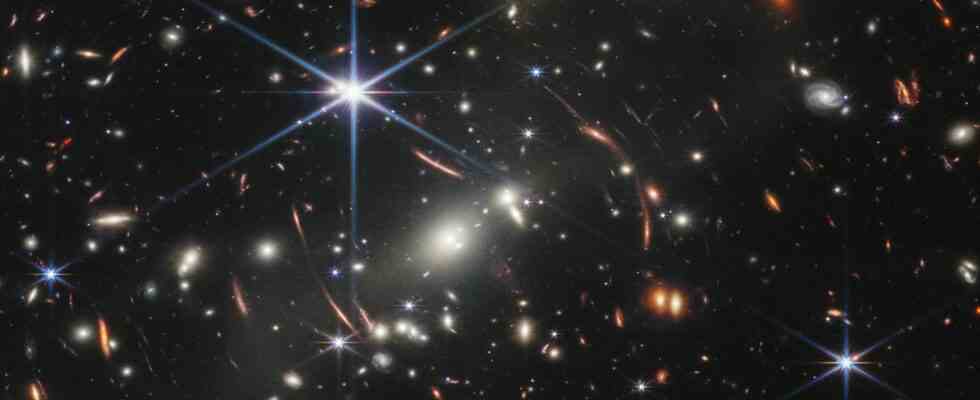First color image
13 billion years back in time: NASA releases image from the James Webb Space Telescope
The first color image from the James Webb Space Telescope. Scientists hope that the images taken by the telescope will provide insights into the time after the Big Bang around 13.8 billion years ago.
© Space Telescope Science Institute/NASA/ESA/CSA/DPA
Cost explosions and shifts overshadowed the launch of “James Webb” – now the most powerful space telescope to date should show what it can do. President Biden offers a foretaste.
Together with US President Joe Biden and his vice president Kamala Harris, the US space agency Nasa presented the “deepest and sharpest infrared view of the universe recorded to date”.
Stars and galaxies can be seen in the first picture taken by the James Webb space telescope, which was launched around six months ago and was published in the White House. Biden spoke of a “historic day”, Harris of an “exciting new capital in the exploration of our universe”.
The image only shows “a small part of the universe,” said NASA CEO Bill Nelson. His explanation to Biden: “The light you see in one of these little blobs has been en route for 13 billion years.” The images from the James Webb telescope would remind the world “that America can do great things,” Biden said. At the same time, he admitted that the idea of the approximately 1.5 million kilometers that the telescope is supposed to fly into space “breaks my brain”.
James Webb Telescope: More images will follow Tuesday
On Tuesday (from 4.30 p.m. CEST) Nasa wanted to publish more images taken by the telescope. The color images were selected by representatives of various space agencies involved in the project and showed, among other things, the so-called Carina Nebula, a type of gas cloud, and the planet “Wasp-96 b” located outside our solar system, Nasa had previously announced. The publication of the photos also marks the official start of scientific work with the largest and most powerful telescope ever launched.
Nasa had already presented a kind of preview last week: the section of an image showing stars and galaxies was created with 72 images over a period of 32 hours. It is “one of the most profound recordings ever made of the universe,” it said. Actually, it’s just a test image taken by a sensor that wasn’t originally supposed to be sent to Earth – but it shows what the telescope will be capable of.
The telescope had already sent the first test images to earth a few months ago, including photos of a star and a selfie. The still somewhat blurry images were also test images intended to prove that the camera and the 18 mirror segments of the telescope are basically working.
“James Webb” was launched on December 25 aboard an Ariane launch vehicle from the European space station in Kourou in French Guiana – after there had previously been cost explosions and repeated postponements. The space agencies of the USA, Canada and Europe are cooperating on the project.
Telescope to fly 1.5 million kilometers into space
The “James Webb Space Telescope” (JWST) took around 30 years to develop and ultimately cost around 10 billion dollars (around 8.8 billion euros). It follows the Hubble telescope, which has been in use for more than 30 years. While “Hubble” works in the optical and ultraviolet range, “James Webb” investigates in the near-infrared range.
“James Webb” is to fly around 1.5 million kilometers into space and, among other things, provide new images from the early universe with the help of a 25 square meter mirror. Scientists hope that the images taken by the telescope will provide insights into the time after the Big Bang around 13.8 billion years ago. They’re hoping for images of stars older than our solar system and perhaps no longer in existence — and possibly even evidence of a second Earth. The lifespan of “James Webb” is initially set at ten years.

